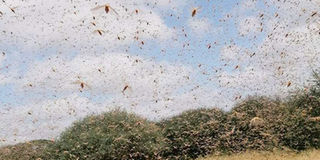Locusts invade Uganda as Tanzania deploys experts

A swarm of locusts destroys vegetation in Garbatulla, Isiolo County. The insects entered Uganda through Turkana and Samburu areas. PHOTO | FILE | NATION MEDIA GROUP
What you need to know:
- The locusts migrated from Kenya's Turkana and Samburu areas.
Desert locusts on Sunday crossed from neighbouring Kenya into Uganda through Amudat in the northeastern part of the country, a government official said.
"It's true they (locusts) have entered into Uganda. They are already inside Amudat district," Martin Owor, commissioner in charge of disaster management, said.
Ugandan Prime Minister Ruhakana Rugunda called for an emergency meeting later on Sunday, Mr Owor said, adding that the government has a plan to fight the locusts, which migrated from Kenya's Turkana and Samburu areas.
He said that security personnel and surveillance teams have already been deployed to help fight the pests, and that Uganda's government officials on Sunday travelled to Kenya to meet their counterparts on agreements to allow spray planes to cross borders.
Uganda last week released Ush15 billion (about $4.5 million) as a contingency fund to help fight the locusts.
The East African country last experienced a major locust invasion 70 years ago, which caused immense damage on crops, according to the agriculture ministry.
According to the UN Food and Agriculture Organization, the desert locust is considered as the most destructive migratory pest in the world. A small swarm covering one square kilometre can eat the same amount of food in one day as 35,000 people.
Meanwhile Tanzanian authorities on Sunday refuted rumours that swarms of desert locusts have invaded the northern region of Kilimanjaro close to the border with Kenya.
Japhet Hasunga, the Minister for Agriculture, said agricultural experts have been dispatched on the Tanzania-Kenya border to monitor any invasion of the locusts that have devastated farm crops and vegetation in the neighboring country.
"Until now our experts have not spotted any invasion of the locusts in Kilimanjaro region and other parts of the country," Hasunga told Xinhua in a phone interview after social media had reported invasion of the locusts in Moshi district.
"The feedback we are receiving from the experts indicate that they spotted two or three locusts at Uru in Moshi district today (Sunday). But an invasion is declared when the locusts are spotted in swarms," said the minister.
On Saturday, Hasunga said the government has hired three spray planes in preparation to possible invasion of the locusts which have devastated eastern Africa in recent weeks.





